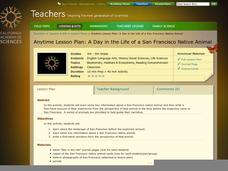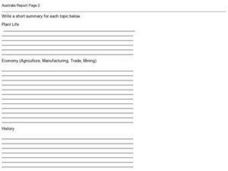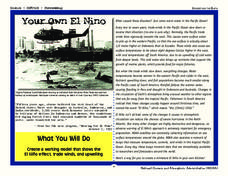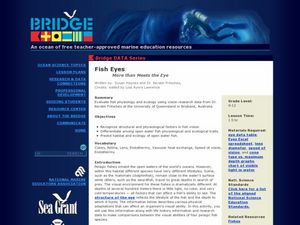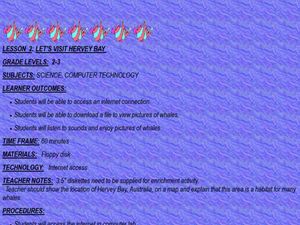National Wildlife Federation
Ghost Town
Around 93 percent of the reefs on Australia's Great Barrier Reef have been bleached, and almost one quarter of them are now dead. Scholars research the sea temperatures, especially around the areas with coral reefs, to make connections...
California Academy of Science
A Day inthe Life of a San Francisco Native Animal
Although the lesson is specifically about the San Francisco Bay area, it's good enough to be adapted to any local region. Children research what the landscape in San Francisco was like prior to settlement, they consider the types of...
Curated OER
The Koala Life Cycle
Students ask and answer questions about the koala life cycle while visiting the zoo. In this koala lesson plan, students review mammal characteristics, read books about koalas, and answer questions about koalas while at the zoo.
NOAA
Coastal Dynamics
Life's a beach! The 16th installment of a 23-part NOAA Enrichment in Marine sciences and Oceanography (NEMO) program first examines different types of coasts and how they form. An activity then has learners investigate the shoreline...
Curated OER
Sonar and Marine Mammals
In this marine science activity, students study online reports and data on sonar effects on marine animals. They complete 7 short answer questions that follow.
Curated OER
Rate of Coral Growth
Using a table of information provided, middle school marine biologists chart data on a graph to determine the impact of water depth on coral growth in Australia's Great Barrier Reef. Then they answer questions that connect the data to...
Curated OER
Exploring Life in the Coral Reef
Students study life forms in coral reefs. In this ocean life lesson plan, students study life in coral reefs as they create a coral reef sculpture.
Curated OER
Australia Report (Page 2)
For this Australia Report worksheet, students write a short summary of Australia's plant life, economy including agriculture, manufacturing, trade and mining and the history of Australia.
Curated OER
Sea Connections
Students, after locating different marine habitats on a globe, play a card game about ecosystems, food webs and organisms.
NOAA
Your Own El Nino
Scholars make a model to discover how the force of trade winds over the Pacific Ocean creates an El Niño. Super scientists observe how the severe weather affects life in water and on land.
Curated OER
Fish Eyes - More than Meets the Eye
Inform your class about the adaptations in fish eyes: cones, lens size, endothermy, and speed of vision. The adaptations are related to diving behavior. Junior marine scientists compare the adaptations of four different fish species to...
Curated OER
Our Disastrous World
Students explore natural disasters around the world from the experiences of other students, friends and families. They collaborate with countries such as Japan, China, India, Australia, Russia, Great Britain as well as from the United...
Curated OER
El Niño ~ The Return of El Niño
El Niño sure creates a stir when it comes around! Why not stir up your earth science class with this data analysis activity that examines the temperature and precipitation over the 2002-2003 water year. A tracking chart is provided...
American Museum of Natural History
Saving Species
Some scientists dedicate their lives to researching and protecting endangered species. An online lesson teaches about three scientists around the world who do just that. They learn about spiders, mollusks, and reptiles from North...
Curated OER
A Day in the Life of a San Francisco Native Animal
Students write from an animal's perspective. In this writing lesson students explore the landscape of San Francisco prior to the arrival of the explorers. Students research animals indigenous to the area.
Smithsonian Institution
Watching Crystals Grow
Amazing science can sometimes happen right before your eyes! The class gets cozy as they watch crystals grow. They use Epsom salts, rocks, and food coloring to create crystals. They'll observe the entire process, documenting every step...
Curated OER
Let's Visit Hervey Bay
Students explore the concept of saving files on the computer. In this computer technology and science activity, students download pictures, facts, and sounds of whales and save them to a disk. Students then discuss the...
Curated OER
A Tree Is A Home...
In this science worksheet, 3rd graders answer 12 clues to find the answers to a crossword puzzle that is focused on things that live in trees. They use words such as butterfly, tree frogs, raccoons, and squirrel.
Curated OER
Deep Sea Coral Biodiversity
Learners research life forms of both tropical coral reefs and deep-sea coral reefs to discover the biodiversity of the ecosystems. They compare and contrast the diversity and adaptations of the two eco-systems, and draw a picture showing...
Curated OER
Review of Evolution
In this review of evolution worksheet, students complete 50 multiple answer questions on Darwin's theory and the history of life on Earth.
Curated OER
Australia, Oceania, and Antarctica Today
Students explore the importance of research in Antarctica, then explain how snow becomes part of the Antarctic ice cap. They explore Antarctica's harsh environment and discover how scientists drill ice cores and what information ice...
Clean Up Australia
Why are Batteries Harmful to the Environment?
Open this lesson plan by reading together about primary and secondary batteries (such as nickel-cadmium cells), problems they can cause in the environment, and how humans can minimize the damage. Afterward, little ones examine a...
K12 Reader
Chaparral Ecosystems
Explore the impact of wildfires with a reading passage about ecosystems. Pupils read the passage and respond to five questions related to the content of the text.
Curated OER
Tree of Life
Students explore the importance of the tropical rain forest in different cultures. Through a cooperative game, they locate countries that are known for their forest resources. Students discuss the similarities and differences of various...



